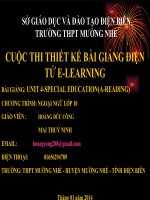Slide english 10 unit 9 undersea world _reading _N.T Ni
Bạn đang xem bản rút gọn của tài liệu. Xem và tải ngay bản đầy đủ của tài liệu tại đây (2.1 MB, 28 trang )
UBND TỈNH ĐIỆN BIÊN
SỞ GIÁO DỤC VÀ ĐÀO TẠO
Bài giảng
Chương trình tiếng Anh lớp, 10
Giáo viên: Nguyễn Thị Ni
Email:
Điện thoại di động: 0973640573
Trường THPT Tủa Chùa, huyện Tủa Chùa, tỉnh Điện Biên
Tháng 1 năm 2015
W
h
a
t
c
a
n
y
o
u
s
e
e
i
n
t
h
e
f
o
l
l
o
w
i
n
g
p
i
c
t
u
r
e
s
?
N
a
m
e
t
h
e
s
e
a
a
n
i
m
a
l
i
n
e
a
c
h
p
i
c
t
u
r
e
i
n
o
n
e
m
i
n
u
t
e
.
Seal
Jelly fish
Turtle
Sea star
Whale
Sea horse
Octopus
Đại
Tây
Dương
Bắc Băng
Dương
I. BEFORE YOU READ
Look at the world
map and match the
names with
appropriate oceans
3. Pacific ocean
1. Atlantic ocean
2. Indian ocean
is the largest of the Earth's
oceanic divisions at 165.25
million square kilometres. It
extends from the Arctic in
the north to the Southern
Ocean in the South, bounded
by Asia and Australia in the
west, and the America in the
east.
Asia
Australia
Arctic
America
Southern Ocean
Pacific Ocean
3. The Pacific Ocean
is the world's second
largest ocean. with a total
area of about 106.4 million
square kilometres. It has S-
shaped Europe and Africa to
the east, and the America to
the west, the Arctic Ocean in
the north, the Pacific Ocean
in the southwest, the India
Ocean in the southeast, and
the Southern Ocean in the
south.
America
Arcc ocean
Pacic Ocean
Indian
Ocean
Southern Ocean
!
!
"#
$
1. The Atlantic Ocean
is the
third largest of the
world's oceanic divisions,
It is bounded by Asia
including India in the north,
on the west by Africa, in the
east by Australia, and in the
south by the Southern Ocean
Asia
Africa
Australia
Southern Ocean
!
Indian
Ocean
3. The Indian Ocean
II. While YOU READ
Pre-teaching Vocabulary
Bay (n) /bei/
E.g:Last week, I visited Halong Bay
: Vịnh
Beneath (prep) /bi'ni:θ/
E.g: Many kinds of sea animals are beneath the ocean
: Dưới
Submarine (n) /'sʌbməri:n/
Water current (n)
/'wɔ:tə 'kʌrənt/
Organism (n)/'ɔ:gənizm/
:Tàu ngầm
: Sinh vật
:Dòng nước
Be at stake
: Bị đe dọa
II. While YOU READ
Reading text
There is only one ocean. It is divided into five different
parts: the Pacific, Atlantic, Indian, Antarctic, and Arctic
Oceans. There are also many other smaller seas, gulfs and
bays which form part of them. Altogether they cover 75
percent of the earth’s surface. For centuries, people have
been challenged by the mysteries that lie beneath the
ocean. However, today’s scientists have overcome many of
the challenges of the depth by using modern devices. They
send submarines to investigate the seabed and bring
samples of marine life back to the surface for further
study. Satellite photographs provide a wide range of
information, including water temperature, depth and the
undersea populations. If modern technology did not exist,
we would never have such precious information.
Reading text (continue)
.
Marine plants and animals fall into three
major groups. Some of them live on or depend on
the bottom like the starfish. Some are swimming
animals such as fishes and sharks that move
independently of water currents while others are
tiny organisms that are carried along by the
currents like the jellyfish. Plants and animals of
the sea, however small or oversized, all contribute
to its biodiversity. Unless this biodiversity were
maintained, marine life would be at stake.
Task 1: Read the passage and decide whether the
following sentences are True (T) or False (F)
%$&&&'&(
)*
)+"
,-,"./0
#*
,-,"./0
#*
1-,"./0
#*
1-,"./0
#*
2*0&"/3
2*0&"/3
2*04
2*04
04
04
2*&&05*#
""/
2*&&05*#
""/
2**05*#
6#*
2**05*#
6#*
7*6
7*6
,"
,"
8+*9":6""&
6//"6
)
*
)+"
,-,"./0
#*
,-,"./0
#*
1-,"./0
#*
1-,"./0
#*
2*0&"/3
2*0&"/3
2*04
2*04
04
04
2*&&05*#
""/
2*&&05*#
""/
2**05*#
6#*
2**05*#
6#*
7*6
7*6
,"
,"
;&/:#:/
""&
)*
)+"
,-,"./0
#*
,-,"./0
#*
1-,"./0
#*
1-,"./0
#*
2*0&"/3
2*0&"/3
2*04
2*04
04
04
2*&&05*#
""/
2*&&05*#
""/
2**05*#
6#*
2**05*#
6#*
7*6
7*6
,"
,"
<1&"/&&=90
0*"&**#
)*
)+"
,-,"./0
#*
,-,"./0
#*
1-,"./0
#*
1-,"./0
#*
2*0&"/3
2*0&"/3
2*04
2*04
04
04
2*&&05*#
""/
2*&&05*#
""/
2**05*#
6#*
2**05*#
6#*
7*6
7*6
,"
,"
>'"&&
6?
)*
)+"
,-,"./0
#*
,-,"./0
#*
1-,"./0
#*
1-,"./0
#*
2*0&"/3
2*0&"/3
2*04
2*04
04
04
2*&&05*#
""/
2*&&05*#
""/
2**05*#
6#*
2**05*#
6#*
7*6
7*6
,"
,"
@+&.&"6/
*
)*
)+"
,-,"./0
#*
,-,"./0
#*
1-,"./0
#*
1-,"./0
#*
2*0&"/3
2*0&"/3
2*04
2*04
04
04
2*&&05*#
""/
2*&&05*#
""/
2**05*#
6#*
2**05*#
6#*
7*6
7*6
,"
,"
A16&/0:&9
"0*"&6.
)*
)+"
,-,"./0
#*
,-,"./0
#*
1-,"./0
#*
1-,"./0
#*
2*0&"/3
2*0&"/3
2*04
2*04
04
04
2*&&05*#
""/
2*&&05*#
""/
2**05*#
6#*
2**05*#
6#*
7*6
7*6
,"
,"
B&C"&
Your Score DE
Max Score D=-E
Number of Quiz
A$empts
D"-?E
F*#+&6.GH01#C""
I
F*#+&6.GH01#C""
I
H0F*J,#*
Task 2: Read the passage and choose the best
illustration for the following information
1. The percentage that all oceans cover the earth’s surface
2. Marine life
,
Check
Check
3. The number of major groups of marine plants and
animals
< @
;
,
Group 2: Species live on or depend on the bottom.
Group 1: Swimming animals
Group 3: Tiny organisms are carried along by the currents
,
4. Match the major groups of marine plants and animals with
suitable picture.
Check
,
Look at the following spider grams. Give names
of some animals in each group of marine animals
using the given words in the box
III. After YOU READ









